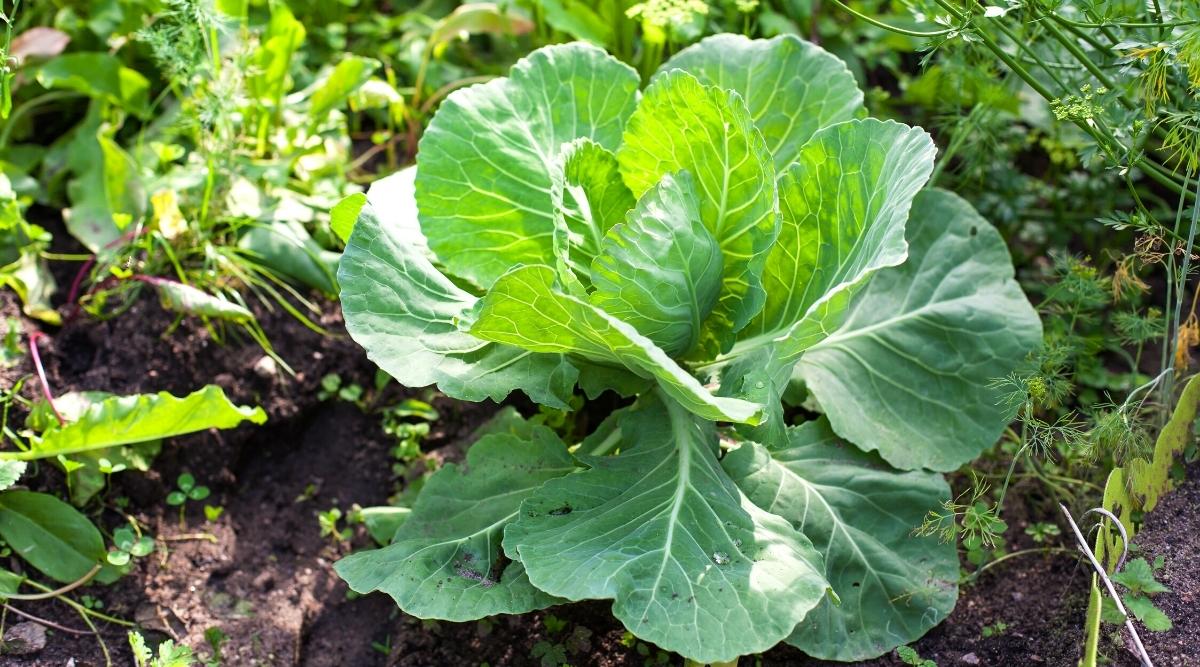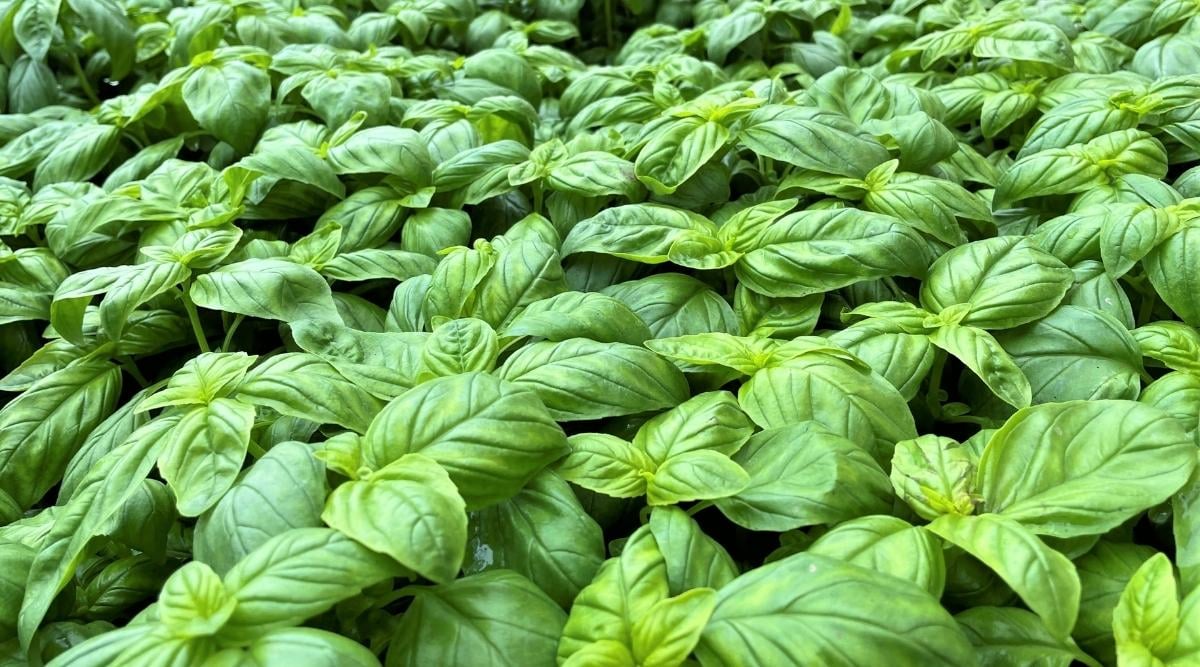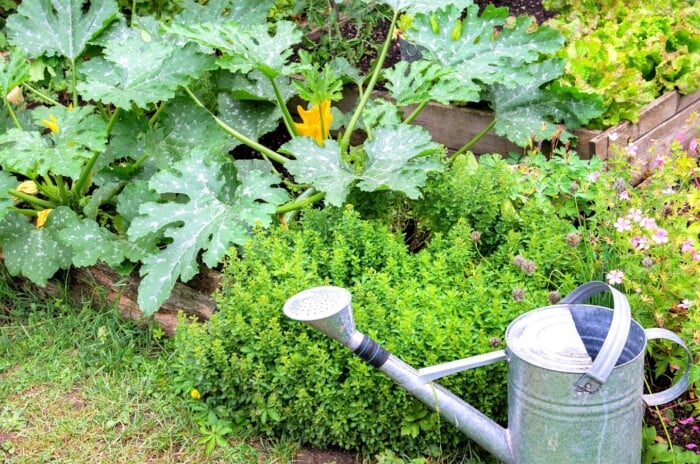21 Cabbage Companion Plants You Can Grow With Cabbage
Companion planting can be an art form, specifically if you have limited gardening space. Cabbage is a shade friendly veggie that can grow well with a number of different vegetables. In this article, gardening expert and former organic farmer Sarah Hyde examines her favorite companion plants for cabbage in your garden.

Dreaming of growing your own cabbage? Homemade sauerkraut in your future? Maybe you want to learn to make your family’s traditional cabbage rolls? When you grow cabbage, companion planting them with other crops can help improve the yield of your harvest, and maximize the space in your garden beds.
But, the question becomes, what should you plant with cabbage? Are there certain vegetables, herbs, or flowers that pair better with this lovely garden vegetable? The good news is you have lots of options, as cabbage is a fairly good partner when it comes to paring with other vegetables.
In this article we take a deeper look at our favorite companion plants to grow with cabbage, as well as what not to grow with cabbage. We dive into vegetables, herbs, and flowers that grow well together. Let’s jump in!
Contents
Brassica Crops & Companion Planting

Botanically, cabbage is a member of the brassica plant family, along with kale, cauliflower, brussels sprouts, and Asian greens. Brassicas are also known as cole or crucifer crops. The name crucifer refers to the distinct cross-shaped flowers these plants bear.
All brassicas have similar nutrient demands on the soil, growth habits, and pest problems. In fact, cabbage, cauliflower, Brussels sprouts, kale and broccoli are actually the same species and genus but have been bred for different edible parts!
Companion Planting Explained

Companion planting is intentionally growing certain plants next to each other to reap benefits of growing them together. Companion planting may encourage plant health and reduce pest and disease pressure.
Companion planting increases diversity in the garden, especially in small spaces, and helps maximize space for square foot gardening. Companion planting is also used to maximize garden space if two plants have different maturity rates and growth habits.
Important Considerations

Before you add cabbage to your garden, make sure you have ample space to allow it to grow to maturity! Cabbage plants can become HUGE, up to four feet across! Don’t skimp on space for cabbage – you’ll have brussels-sprouts size heads if they are too crowded.
Keep in mind that mature, immense cabbage leaves will shade out anything growing underneath them! Small-headed, compact cabbage varieties are available, but the plants still require a few feet of growing space per plant.
Cabbage plants are best grown as transplants. If you are starting from seed you may have many options of types to grow, including red, green, conical and savoyed leaf. Growing unique varieties adds even more interest to your garden.
They also need ample fertilizer or compost during the growing season. Cabbage specifically needs regular water for even leaf formation in the head. Too much water can cause splitting in the head. Make sure you plan for both space and fertility when you decide to plant cabbage.
Cabbage thrives in cool spring and fall weather. Mature plants can withstand fall frost, and even small transplants can weather a few freezing spring nights with little problem. The goal is to have your spring cabbage mature before the extremely hot days of summer, or in the cool late fall days.
Persistent hot summer temperatures will cause the cabbage to taste bitter and increase the possibility of dry-edged leaves in the inside of the head as it forms. Stress from the heat makes cabbage plants more susceptible to pests and diseases.
Vegetable Companions
There are many different types of crops that will perform quite well with cabbage. First up, we take a look at some of the top vegetables you can plant with cabbage to maximize the space inside your garden beds, and produce bigger crop yields.
Carrots

Carrots make great companion plants for cabbage, due to different growth habits and little to no shared pests, and they both can grow well in cooler weather. Carrots take up garden space primarily underground (though they can get tall tops depending on the variety). Cabbage needs less root space and more above ground space so they can share the same garden area for part of their life.
Plant carrots early in the spring, when your cabbage transplants are still safe inside the nursery’s greenhouse or your windowsill (or wherever you grow your transplants!). When cabbage planting time comes, hopefully, your carrots will have germinated and are at least a few inches tall. Allow both plants to grow together.
As the cabbage plant increases in size, it will start to shade the carrots. Harvest baby carrots from around the cabbage plant’s growing base as they are shaded out, leaving the furthest away carrots to grow to full size.
Beets

Beets are a great companion plant for cabbage too, since they are similar in growth habit to carrots, as described above. They also share a few pests with cabbage. Beets are a great choice because they tend to be a bit easier to grow for novice gardeners than carrots.
Beets can be harvested at the baby stage for sweet, tender treats. Beets have another super power that makes them excellent companion plants – their greens! As the beets mature around the cabbage, harvest the greens to allow more space for the cabbage plant. Beet greens rival Swiss chard for health benefits and flavor.
Lettuce

Lettuce is an excellent choice for planting next to cabbage, though it doesn’t offer specific benefits in terms of pest protection. Lettuce and cabbage both prefer cool weather. Lettuce is an easy-going, quick crop that can be harvested multiple times. Lettuce can be planted before or at the time of transplanting cabbage.
The lettuce will mature in half the time as the cabbage and will regrow from harvested leaves for a second or even third harvest. As the lettuce and cabbage mature, keep harvesting the lettuce from around the cabbage plant before it gets shaded out.
Lettuce generally does not do well in the heat, so you can harvest all the lettuce and cabbage before the heat of summer. That leaves you with an open space to plant a heat loving crop. For example, pop in some okra or basil transplants in the space where cabbage and lettuce grew.
Scallions

Scallions are excellent space savers since they grow small and lean. Sow scallion seeds directly into the garden as early as soil can be worked and be patient.
They are slow growers. Allow them to get past the “grass-stage” where the baby scallions resemble blades of grass, before planting cabbage transplants with them.
Scallions can be planted around the cabbage plants similar to how lettuce, carrots, and beets were described above. Scallions can be harvested at any stage after they are the size of a pencil, and have a long harvest window. Again, harvest the scallions closest to cabbage first, as the cabbage will eventually shade out the nearest scallions.
Spinach

Spinach thrives in cool weather and is one of the first seeds you can plant in the spring – even when it is still freezing at night! It is also a “cut-and-come-again” crop, meaning if you harvest only some leaves from each plant it will continue to produce.
This makes it a great plant to establish and harvest from for a few weeks before putting in your cabbage plants. Similar to lettuce, harvest the spinach from around the cabbage plant until it gets shaded out.
One caution – aphids do love to hang out under the curled spinach leaves, especially as the weather warms. Keep an eye out that the aphids don’t move onto your cabbage plants. Remove spinach as the weather gets hot, even if it happens before your cabbage head is fully mature.
Dandelion Greens

Dandelion greens are an unsung heroine of the garden due to their high nutrient content and few pests. They can churn out healthy greens all season long, even after you’ve pulled the cabbage plants in the summer heat!
Dandelion seed you purchase for planting is botanically different from the common yellow flowering lawn weed. Dandelion greens are actually chicory and are the same species as endive.
When spaced closely, dandelion greens will grow somewhat vertically, which makes them a great space saver next to space-hogging cabbage. Again, as the cabbage grows, harvest the dandelion green plants as they get shaded out.
Celery

Celery has been purported to repel cabbage moths, which makes it a good choice for companion planting with cabbage. Even if cabbage moths were to find your cabbage, chances are good they would not move onto the celery. Celery and cabbage both are best grown as transplants, prefer cooler weather, and need regular water for ideal growth formation.
Celery and cabbage are very close in their days to maturity (approimately 75-85 days depending on variety). This makes them good companions because once both crops are done, you remove the plants in their entirety and make space for a new crop.
Since celery and cabbage struggle in hot weather, this opens up space in your garden for a new summer crop – basil transplants, beans, okra, or zinnias for example.
Mâche

Mâche, Vit, and Lamb’s Lettuce are all names for the most fabulous under-recognized garden crop that also makes a great companion for cabbage. With a similar growth habit to spinach, mâche can be sown very early, as soon as the soil can be worked.
Mâche has a mild, nutty flavor you won’t find anywhere else in the garden. Though it is slow to germinate and grow, the wait is worth it!
Mâche can withstand cold temperatures and can be sown early, so it will grow into a harvestable plant by the time the cabbage transplants go in. While the cabbage is growing to maturity, keep harvesting your mâche from around the plant.
Careful harvesting will allow mâche to be a cut-and-come-again crop. Mâche and cabbage don’t share many pests aside from aphids, so they can be great garden companions!
Onions

Onions are very rewarding to grow in your garden since you can enjoy the fruits of your labor all year if stored properly after harvest. Onions’ generous aroma also repels many pests that attack cabbage – cabbage moths, cabbage loopers, aphids, and rabbits! That alone makes them great companion plants.
If you practice garden rotation (which you should be!) planting onions next to cabbage can simplify your rotation. According to esteemed organic grower Eliot Coleman, onions have been shown to be beneficial preceding cabbage. That means you can just scootch next season’s cabbage crop right where your onions grew.
While bulb onions need more space than scallions mentioned above, they still have an upright growth habit. Onions are heavy feeders like cabbage, so applying a generous dose of compost before planting will benefit both crops.
Garlic

Garlic shares many of the same qualities with onions mentioned above, since they are closely related botanically. Garlic’s strong aroma repels the same pests, which makes it an excellent choice for companion planting with cabbage. Garlic tends to take up slightly less space than onions and can be a good choice along garden bed edges where cabbage takes center stage.
Arugula

Arugula is a beneficial companion plant for cabbage in a way that most other crops listed here are not. Arugula is considered a “trap crop” for flea beetles, which are also a cabbage pest. Flea beetles will eat the tender arugula leaves before tough cabbage leaves.
Seeing them on arugula first gives you a chance to cover your cabbage with insect netting or row cover. Let the flea beetles be on the arugula and consider it a sacrifice crop. Pesticides don’t work particularly well for flea beetles since they fly quickly at any movement.
Herb Companions
Homegrown herbs are the key that takes your fresh-from-the-garden cooking to the next level. Not only do herbs add the pop to every dish, most of them have very pungent aromas that repel pests, making them great companion plants for pest-prone cabbage plants.
Thyme

Thyme’s strong aroma has been said to repel cabbage moths. Thyme can be grown as an annual or perennial, depending on your USDA zone and variety. As a somewhat low-growing plant, try planting thyme around the edges of your beds with cabbages in the center.
When you’ve harvested the cabbage, the thyme will keep on growing and will be a great companion to most any other crop you plant after the cabbage.
Sage

Sage is another aromatic herb that also repels cabbage moths. Sage grows as a perennial in zones 4-8, so many gardeners will see sage return year after year. Sage plants can grow into mini-shrubs so plan to give them enough space. Visually, sage’s light green, dusty leaves will look stunning next to deep blues and purples of cabbage leaves.
Oregano

Oregano is a perennial, pungent herb that is hardy in zones 4-9. This cold-hardiness makes it a great companion crop to a fall batch of cabbage. A mature oregano plant can withstand light frosts, and its pungent odors will keep pests at bay. An easy herb to grow, it will spread if you give it enough space.
Chives

Chives are a beautiful, multipurpose plant that make great companions for cabbage, and are best planted next to cabbage (rather than harvested from underneath). Chives’ strong aroma repels aphids, a major pest for cabbage.
Chives can be slow to establish, but once they’ve gotten a foothold, they will be perennial. They are hardy in zones 3-9 and are one of the first plants to emerge in the spring. Chives not only provide edible greens, which can be harvested, dried, and used year-round – they also have beautiful edible purple flowers!
Catnip

Catnip makes a great companion plant for cabbage since it’s pungent aroma repels flea beetles. It is an edible member of the mint family and can be used for teas.
It has a similar growth habit to oregano and is hardy in zones 3-9 so chances are you’ll see it return year after year. Plus, your furry feline family member will be thanking you for thinking of them in your garden!
Dill

Dill is a great companion plant for cabbage because their flavors pair well in the kitchen. Since dill is not frost-hardy, you will have to wait until your spring cabbage is already actively growing to plant.
The dill seed heads will mature in late summer/early fall and the seed can be harvested to use with your fall cabbage crop in sauerkrauts and cabbage rolls. Dill can be resown throughout the season to have a constant supply of fresh dill leaves.
Basil

Basil can be a great companion planting to cabbage since its strong scent repels most cabbage pests. However, their season together may be short, since basil prefers warm weather and will die with a light touch of frost in the fall.
Plant basil in the spring around your cabbage after the threat of frost has passed. The cabbage will be nearing maturity, so when you’ve harvested a beautiful head, remove the entire plant by cutting it at its base below the soil line. Leaving the cabbage roots adds organic matter to the soil. You will then have plenty of room for the basil to mature over summer.
Flower Companions
There are a few great flower companions, that will help enrich the taste of your vegetables, but also keep both pests and diseases away from them. Let’s take a look at the most common, and popular flower companions to plant with cabbage in your garden.
Marigold

The classic marigold is a gardener’s favorite companion plant since it pairs with virtually any crop. Cabbage benefits from living next to marigolds since the flowers repel cabbage moths. Full-grown marigold plants can tolerate light frosts. This makes them suitable as a companion plant to cabbage for spring and fall crops.
Calendula

Calendula has outstanding medicinal uses and the flower petals themselves are edible. Plus, its pungent floral aroma helps repel cabbage pests. Use the blooms as cut flowers all season long. Calendula leaves are so strongly scented that they will keep working hard to repel cabbage pests, even if you harvest the flowers.
Nasturtium

Nasturtium is both beautiful and edible. Edible nasturtium leaves lend a spicy kick to salads and their orange blossoms bring joy to any garden. Nasturtium’s ability to repel cabbage worms makes them great companions for cabbage plants! Nasturtium is an annual that can thrive in sun and part shade.
Avoid Growing These With Cabbage

There are a few crops that are not cabbage’s best friend. Most reported is that tomatoes planted with cabbage will result in poorly growing, stunted tomatoes.
Corn is not the best choice to plant right next to cabbage. Corn does not provide any specific benefit to cabbage. You may run into space issues as well since both are large plants.
Large cabbage leaves will shade out young corn plants, and if the corn is already tall when you plant cabbage it may shade cabbage. Both crops are also heavy feeders, making large nutrient demands on the soil.
Pumpkins and squash are both poor choices interplanted with cabbage since they all have large leaves and will shade out anything underneath them. Pumpkins and squash are not known to provide any particular benefit to cabbage and are best planted in their own space.
Final Thoughts
Growing your own cabbage is a great way to beautify your garden, try unique cabbage varieties not found in stores, and experience the difference in the flavor of fresh-picked cabbage. Companion planting these suggested crops with cabbage is a great way to maximize benefits from both crops. Try different combinations for your space and see what works best for your garden!








